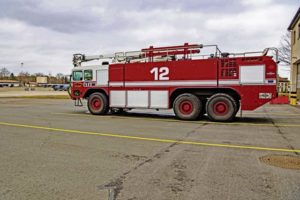The 86th Civil Engineering Squadron Fire Emergency Service section provides on-demand support for all emergencies on Rhine Ordnance Barracks, Vogelweh Military Complex, Kapaun Air Station, Landstuhl Regional Medical Facility, and Ramstein Air Base.
The section has eight departments that need to meet specific response times. Once the call is received, dispatch has one minute to forward the information, one minute to start responding, and five minutes to respond to the call.

The fire department can be expected to respond to a multitude of calls, so Airmen serve a multifunctional role as firefighters. Airmen can react to either in-flight or ground emergencies involving aircraft, fire alarms, confirmed fires, medical responses, and motor vehicle accidents.
“Realistically, we never know what the situation will be until we arrive at the site,” said U.S. Air Force Staff Sgt. Jacob Levee, 86 CES lead firefighter.
When responding to a call, Airmen need to pull hoses, carry water cans and axes, read fire patterns, read wind directions, operate the fire truck, and solve equations to predict the amount of water necessary to put out the fire.
“When responding to a fire, you need to know how much water to give the person fighting the fire because you don’t want to give them too much water,” said Airman 1st Class Nathanael Johnson, 86 CES firefighter. “Too much water makes it hard to control the hose or causes unnecessary damage to whatever is on fire.”
While on the scene, sometimes firefighters have to work with other sections of 86 CES to assist with the emergency.
“I was responding to a call and on the scene a hot water pipe burst,” said Levee. “So, we had the issue of scalding hot water interfering with electronics, which is an overall dangerous situation.”
Airmen train daily to ensure their readiness. The extent of the training may be different day-to-day. Firefighters have a yearly requirement for structural and live-fire aircraft burns.
“It’s imperative that we be ready because of the wide variety of incidents that we can respond to and how we correct the situations once we respond on the scene,’’ said Levee. “Sometimes it’s a situation we haven’t seen before, but having the training teaches you the generalized idea and the best way to handle the situation.”
Unlike Airmen from other squadrons, firefighters respond at any given time. Depending on the station, firefighters may work 24 or 48-hour operations.
“It’s key that Airmen arriving to the station adapt because it can be hard waking up in the middle of the night and continuing to function depending on the shift we are working,” said Levee.
During a 24-hour shift, Airmen often spend lots of time together, giving them time to engage in a way Airmen don’t experience in other squadrons.
“We have to adapt to each other, and gaining that experience together is very helpful,” said Johnson. “When we arrive on the scene, we’re expected to be a jack-of-all-trades, and having a team that is knowledgeable in each field is immensely helpful when we all respond together.”


